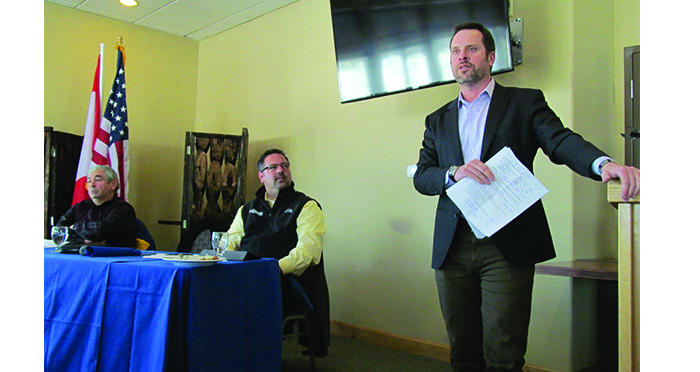
Redmond Leaders Tout City’s Economic Vitality
(Photo above: Redmond City Manager Keith Witcosky listens to an audience member’s question during the Redmond Rotary Club’s City Leadership Panel as Redmond Mayor George Endicott, left, and Redmond Economic Development Inc. Executive Director Jon Stark look on | courtesy of Steve Kadel)
The past year was prosperous for Redmond businesses, led by job growth in manufacturing industries that was significantly above state and national levels.
That good news was delivered by Jon Stark, Redmond Economic Development Inc. executive director, during the January 5 Redmond Rotary Club’s City Leadership Panel at Juniper Golf Course.
“We are definitely back on our feet,” Stark said of recovery from the recession, “and everything we are hearing for 2017 points to a great year.”
He was joined by Redmond City Manager Keith Witcosky and Redmond Mayor George Endicott as panelists.
Stark pointed out that 2016 was the year Redmond experienced net employment growth after the recession. Most of the incoming workers were from Portland, Seattle and California, he said.
The Bend-Redmond metropolitan statistical area ranked in the top 10 of 300 such areas during 2016, Stark noted. In addition, the Milken Institute listed Bend-Redmond as the nation’s top-performing small metro area based on wage growth, job growth, healthcare availability and other factors.
Stark pointed to PCC Schlosser, a Redmond titanium cast plant, as one of the city’s success stories. The firm reduced its workforce to about 200 in 2010, but now employs 400 people.
He added that Consumer Cellular has opened after the closure of T-Mobile and now has 500 employees. Central Oregon Truck Co. consolidated its Prineville and Terrebonne locations in Redmond with overall company employment rising significantly.
Stark mentioned BasX Solutions as a company “doing some great things” with more than 200 employees. The firm was one of Oregon’s fastest growing in 2016.
Stark said the diversity of Redmond’s employer base is one of the city’s strengths.
The future looks bright, he said, because there are leads on six companies that could add 1,000 jobs in Redmond. The city is attractive to prospective companies because there is sufficient land for building, Stark said, citing a developer who has broken ground on a 23,000-square-foot facility that is scheduled to open in late spring. There’s also interest in developing the first industrial park in more than a decade, Stark said.
“Hopefully we’ll continue to make (Redmond) a good place to grow,” he said.
Endicott said another Redmond attraction is its lack of wetlands in potential construction areas.
“Redmond is one of few communities in Oregon with no issues about wetlands in buildable areas,” he said. “Companies would rather locate here and blast rock instead of dealing with the wetlands in the (Willamette) Valley.”
He said growth of 2 to 4 percent is manageable, but warned against too much too quickly.
“High growth is a good thing to a point,” Endicott said, adding that infrastructure costs also must be considered.
Witcosky said the city is finishing the feasibility study for a large sports complex that would be located at the fairgrounds.
“We’re trying to leverage sports tourism” such as large basketball tournaments, he said. “It would be a huge opportunity for Redmond.”
Another big project is a $2.5 million U.S. Forest Service dispatch center at the airport, Witcosky said. It will be the hub for fighting wild land fires.
“That’s under construction and will serve this community very well,” Witcosky said.
Transportation is another area of possible growth. The city manager said Redmond and Bend city officials have been discussing the idea of adding Uber as a travel option, particularly in light of the record number of air passengers visiting Central Oregon.
An agreement with the Oregon Department of Transportation is intended to reduce the number of serious automobile crashes at Highway 126 and 35th Street. That $500,000 project will add a turn lane to reduce the danger, with a traffic signal a future goal, according to Witcosky. Work will start on the turn lane as soon as asphalt is available after the winter.
Possible new amenities that will attract businesses to Redmond include a walking path along the canal.
“We want to create a nice place for people to walk and not just drive,” Witcosky said.
During a question-and-answer period, audience members wanted to know about plans for affordable housing. Endicott said six to eight “master plans” for housing developments are pending with the city. He wants developers to build “what people want” and said there’s currently little if any demand for high-level or executive type residences.
“There’s enough on the books right now to satisfy the housing needs for two years,” said Stark. “It just isn’t built yet.”
Another audience member asked what city officials predict as Redmond’s population in the future. Witcosky said population projections from Portland State University show the city will grow by 1 to 2 percent over the near future, reaching a population of 32,000 to 42,000 by 2040.
“It’s not massive leaps,” he said.






